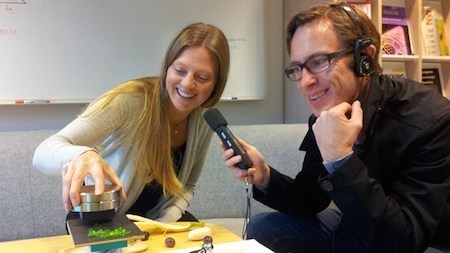Marc Abrahams's Blog, page 370
October 11, 2014
The Butcher’s Tongue Illusion (from the chip-crunch manipulator)
 Charles Spence (who was awarded an Ig Nobel Prize for earlier work, and who is pictured here) and his colleagues have demonstrated the “butcher’s tongue illusion”. Nicola Twilley, writing in Elements, conveys some of the new study’s flavor:
Charles Spence (who was awarded an Ig Nobel Prize for earlier work, and who is pictured here) and his colleagues have demonstrated the “butcher’s tongue illusion”. Nicola Twilley, writing in Elements, conveys some of the new study’s flavor:
The tongue in the title of Oxford University’s Crossmodal Research Laboratory’s new paper, “The Butcher’s Tongue Illusion,” does not come from a butcher shop. “I actually just ordered the most normal-looking rubber tongue from a magic store,” Charles Michel, the report’s lead author and a professionally trained chef, said. “Magicians put them in their mouths and tie them in knots and things like that.”
Michel and his co-authors put their magic tongue to use in a simple but provocative experiment, carried out late last year and described in the current issue of the scientific journal Perception. Although the involvement of a stretchy pink latex tongue makes it easy to mistake the experiment for a cheap gag, it’s actually an important addition to a distinguished tradition of psychological research that studies illusions for what they can reveal about how the brain constructs reality.
The team’s goal was to replicate a famous experiment called the “rubber hand illusion.”
This new study is:
“The Butcher’s Tongue Illusion,” Charles Michel, Carlos Velasco, Alejandro Salgado-Montejo, Charles Spence, Perception, vol. 43, 2014, pp. 818 – 824. The team writes:
“We report two experiments, based on a novel variant of the Rubber Hand Illusion (RHI), in which tactile stimulation is referred to an artificial (out-of-body) tongue. In the experiments reported here the participant’s tongue was stimulated while they looked at a mirrored dummy tongue. On average, the participants agreed with the statement that they felt as if they had been touched in the location where they saw the rubber tongue being touched (experiment 1), thus demonstrating visual capture. When the external tongue was illuminated with a laser pointer (experiment 2), a significant proportion of the participants reported feeling either tactile or thermal stimulation on their own tongue. These results therefore demonstrate that the multisensory integration of visual, tactile, and proprioceptive information that gives rise to the RHI can be extended to the tongue (a body part that is rarely seen directly).”
The 2008 Ig Nobel Prize for nutrition was awarded to Massimiliano Zampini of the University of Trento, Italy and Charles Spence of Oxford University, UK, for electronically modifying the sound of a potato chip to make the person chewing the chip believe it to be crisper and fresher than it really is. REFERENCE: “The Role of Auditory Cues in Modulating the Perceived Crispness and Staleness ofPotato Chips,” Massimiliano Zampini and Charles Spence, Journal of Sensory Studies, vol. 19, October 2004, pp. 347-63.

A denture-friction scientist analyses the banana-skin paper
Maria Pettersson, a friction scientist at the Ångström Laboratory at Uppsala University, who is professionally focusing on dentures these days, discusses the Ig Nobel physics prize-winning study that measured the slipperiness of a banana peel. You can listen to the discussion on Sverige Radio [P4]. The discussion is in Swedish.
This action photo shows a moment in that discussion:
The 2014 Ig Nobel Prize for physics was awarded to Kiyoshi Mabuchi, Kensei Tanaka, Daichi Uchijima and Rina Sakai, for measuring the amount of friction between a shoe and a banana skin, and between a banana skin and the floor, when a person steps on a banana skin that’s on the floor. They documented their work, in the paper “Frictional Coefficient under Banana Skin,” Kiyoshi Mabuchi, Kensei Tanaka, Daichi Uchijima and Rina Sakai, Tribology Online 7, no. 3, 2012, pp. 147-151.
* * *
The same radio program took a look back at the study that won the 2003 Ig Nobel Prize for medicine. That prize was awarded to Eleanor Maguire, David Gadian, Ingrid Johnsrude, Catriona Good, John Ashburner, Richard Frackowiak, and Christopher Frith of University College London, for presenting evidence that the brains of London taxi drivers are more highly developed than those of their fellow citizens. The paper is: “Navigation-Related Structural Change In the Hippocampi of Taxi Drivers,” Proceedings of the National Academy of Sciences, vol. 97, no. 8, April 11, 2000, pp. 4398-403. Also see their subsequent publications.
The radio program explains (also in Swedish, of course) how that tax-driver research relates to the research that led to the 2014 Nobel Prize for physiology or medicine.

“Inappropriate”: Old vs. young vs. differing senses of humor
 This study documents a great lesson of some sort that was sought and perhaps learned:
This study documents a great lesson of some sort that was sought and perhaps learned:
“Age-related differences in judgments of inappropriate behavior are related to humor style preferences,” Jennifer Tehan Stanley, Monika Lohani, Derek M. Isaacowitz, Psychology and Aging, Vol 29(3), Sep 2014, 528-541. (Thanks to investigator Erwn Kompanjie for bringing this to our attention.) The authors explain:
“Older adults did not show this pattern, suggesting that they did not find the inappropriate {video} clips funny. Additionally, young adults endorsed a more aggressive humor style than middle-aged and older adults and aggressive humor style endorsement mediated age differences in social appropriateness ratings. Results are discussed in terms of possible mechanisms”
Co-author Stanley [pictured here], at the University of Akron, Ohio, is currently working on another mystery, which will be documented in the study:
Stanley, J. T., Zhang, X., Fung, H. H., & Isaacowitz, D. M. (in press). Cultural differences in gaze and emotion recognition: Americans contrast more than Chinese. Emotion.

October 10, 2014
Abusive Supervision vs. Narcissistic Supervisees
The title of this study (though not quite so much the text of it) suggests that some psychology insights might be gained by doing particle collision experiments — experiments analogous to what some physics researchers do:
“How Do Narcissistic Employees Respond to Abusive Supervision: Two Roles of Narcissism in Decreasing Perception and Increasing Deviance,” Rong Wang and Jiang Jiang, Psychological Reports, epub 2014.
Safety would of course be a concern.

October 9, 2014
On the existence of Stronzo Bestiale
 This is one of the many studies credited to co-author Stronzo Bestiale:
This is one of the many studies credited to co-author Stronzo Bestiale:
“Diffusion in a periodic Lorentz gas,” Bill Moran, William G. Hoover [pictured here], and Stronzo Bestiale, Journal of Statistical Physics , vol. 48, no. 3-4 (1987): 709-726.
The Retraction Watch blog explains about Stronzo Bestiale:
Should papers be retracted if one of the authors is a total asshole?When science writer Vito Tartamella noticed a physics paper co-authored by Stronzo Bestiale (which means “total asshole” in Italian) he did what anyone who’s written a book on surnames would do: He looked it up in the phonebook.
What he found was a lot more complicated than a funny name.
It turns out Stronzo Bestiale doesn’t exist.
In 1987, Lawrence Livermore National Lab physicist William G. Hoover had a paper on molecular dynamics rejected by two journals the Journal of Statistical Physics. So he added Stronzo Bestiale to the list of co-authors, changed the name, and resubmitted the paper. The Journal of Statistical Physics accepted it.
27 years later, Bestiale is still listed as co-author on several papers….
BONUS (possibly related): “On the Existence of Mikhailov“

USB cigarettes (pay-as-you-smoke) patent
Phillip Morris International (PMI) has received (Oct. 7th 2014) its US patent for an ‘Electrically Heated Smoking System’ Unlike many currently available ‘vape’ sticks, the new device can heat actual tobacco rather than evaporating a nicotine-based liquid. And, unusually for a cigarette, it can ‘communicate’ with a host computer/ tablet etc via a USB plug.
 “The host is able to connect to one or more Internet sites in order to upload data or download data or both upload and download data.” If you are wondering what kind of data, the patent document alerts to the possibilities of ‘Pay-as-you-smoke’ apps. : “Other possible capabilities include, but are not limited to: Pay-as-you-smoke functionality. For example the user buys daily or weekly or monthly smoking time from the Internet application supported on the PC, or the user obtains smoking time credits based on cigarettes and other smoking articles bought via the Internet application.” The patent device appears to have much in common with the soon-to-be-launched Marlboro IQOS system. (see page 72 in PMI’s ‘Investor Day – Reduced Risk Products’ document, Lausanne, June 26, 2014)
“The host is able to connect to one or more Internet sites in order to upload data or download data or both upload and download data.” If you are wondering what kind of data, the patent document alerts to the possibilities of ‘Pay-as-you-smoke’ apps. : “Other possible capabilities include, but are not limited to: Pay-as-you-smoke functionality. For example the user buys daily or weekly or monthly smoking time from the Internet application supported on the PC, or the user obtains smoking time credits based on cigarettes and other smoking articles bought via the Internet application.” The patent device appears to have much in common with the soon-to-be-launched Marlboro IQOS system. (see page 72 in PMI’s ‘Investor Day – Reduced Risk Products’ document, Lausanne, June 26, 2014)

October 8, 2014
Life – the mystery continues
 Over the millennia, many have asked themselves (and others) ‘Life – What exactly is it?’ But (definitive) answers came there none. As is confirmed in a 2012 paper by Edouard Machery, who is Associate Professor of History and Philosophy of Science at the University of Pittsburgh, US.
Over the millennia, many have asked themselves (and others) ‘Life – What exactly is it?’ But (definitive) answers came there none. As is confirmed in a 2012 paper by Edouard Machery, who is Associate Professor of History and Philosophy of Science at the University of Pittsburgh, US.
‘Why I Stopped Worrying about the Definition of Life… And why you Should as Well’ is published in the March 2012, issue of the journal Synthese (Volume 185, Issue 1, pp 145-164)
“In several disciplines within science – evolutionary biology, molecular biology, astrobiology, synthetic biology, artificial life – and outside science – primarily, ethics – efforts to define life have recently multiplied. However, no consensus has emerged.”

October 7, 2014
Predators vs artificial prey: Greyhounds & mechanical bunny
What happens if racing greyhounds not just chase, but actually catch the mechanical rabbit? This video documents one such occurrence:
(HT Brendan Koerner)

Coffee & Copious Co-authorship & Causation & Correlation
Coffee, coffee, coffee, multiple co-authorship, coffee, coffee, coffee, the implied linking of correlation and causation,coffee, coffee, coffee, the genome,coffee, coffee, coffee, big data, coffee, coffee, coffee — this new study has plenty of something for lots of everyones:
“Genome-wide meta-analysis identifies six novel loci associated with habitual coffee consumption,” The Coffee and Caffeine Genetics Consortium, M C Cornelis, E M Byrne, T Esko, M A Nalls, A Ganna, N Paynter, K L Monda, N Amin, K Fischer, F Renstrom, J S Ngwa, V Huikari, A Cavadino, I M Nolte, A Teumer, K Yu, P Marques-Vidal, R Rawal, A Manichaikul, M K Wojczynski, J M Vink, J H Zhao, G Burlutsky, J Lahti, V Mikkilä, R N Lemaitre, J Eriksson, S K Musani, T Tanaka, F Geller, J Luan, J Hui, R Mägi, M Dimitriou, M E Garcia, W-K Ho, M J Wright, L M Rose, P K E Magnusson, N L Pedersen, D Couper, B A Oostra, A Hofman, M A Ikram, H W Tiemeier, A G Uitterlinden, F J A van Rooij, I Barroso, I Johansson, L Xue, M Kaakinen, L Milani, C Power, H Snieder, R P Stolk, S E Baumeister, R Biffar, F Gu, F Bastardot, Z Kutalik, D R Jacobs Jr, N G Forouhi, E Mihailov, L Lind, C Lindgren, K Michaëlsson, A Morris, M Jensen, K-T Khaw, R N Luben, J J Wang, S Männistö, M-M Perälä, M Kähönen, T Lehtimäki, J Viikari, D Mozaffarian, K Mukamal, B M Psaty, A Döring, A C Heath, G W Montgomery, N Dahmen, T Carithers, K L Tucker, L Ferrucci, H A Boyd, M Melbye, J L Treur, D Mellström, J J Hottenga, I Prokopenko, A Tönjes, P Deloukas, S Kanoni, M Lorentzon, D K Houston, Y Liu, J Danesh, A Rasheed, M A Mason, A B Zonderman, L Franke, B S Kristal, International Parkinson’s Disease Genomics Consortium (IPDGC), North American Brain Expression Consortium (NABEC), UK Brain Expression Consortium (UKBEC), J Karjalainen, D R Reed, H-J Westra, M K Evans, D Saleheen, T B Harris, G Dedoussis, G Curhan, M Stumvoll, J Beilby, L R Pasquale, B Feenstra, S Bandinelli, J M Ordovas, A T Chan, U Peters, C Ohlsson, C Gieger, N G Martin, M Waldenberger, D S Siscovick, O Raitakari, J G Eriksson, P Mitchell, D J Hunter, P Kraft, E B Rimm, D I Boomsma, I B Borecki, R J F Loos, N J Wareham, P Vollenweider, N Caporaso, H J Grabe, M L Neuhouser,  B H R Wolffenbuttel [pictured here], F B Hu, E Hyppönen, M-R Järvelin, L A Cupples, P W Franks, P M Ridker, C M van Duijn, G Heiss, A Metspalu, K E North, E Ingelsson, J A Nettleton, R M van Dam and D I Chasman, Molecular Psychiatry, epub October 7, 2014.
B H R Wolffenbuttel [pictured here], F B Hu, E Hyppönen, M-R Järvelin, L A Cupples, P W Franks, P M Ridker, C M van Duijn, G Heiss, A Metspalu, K E North, E Ingelsson, J A Nettleton, R M van Dam and D I Chasman, Molecular Psychiatry, epub October 7, 2014.
“We conducted a genome-wide (GW) meta-analysis of predominately regular-type coffee consumption (cups per day) among up to 91 462 coffee consumers of European ancestry with top single-nucleotide polymorphisms (SNPs) followed-up in ~30 062 and 7964 coffee consumers of European and African-American ancestry, respectively. Studies from both stages were combined in a trans-ethnic meta-analysis. Confirmed loci were examined for putative functional and biological relevance.”
BONUS (possibly related): “The Coffee Diet” from “The Atkins Diet Opera”:

A reported discovery about smiling women
The expression on a person’s face might sometimes affect other persons’ perceptions of that person. So suggests this study:
“Forming Impressions: Effects of Facial Expression and Gender Stereotypes,” Tay Hack, Psychological Reports, vol. 114, no. 2, 2014, pp. 1-15. The author, at Angelo State University, writes:
“In conclusion, the present research adds to existing knowledge of how people form impressions of men and women…. The findings suggest that women may be perceived more favorably when displaying a smile.”

Marc Abrahams's Blog
- Marc Abrahams's profile
- 14 followers




